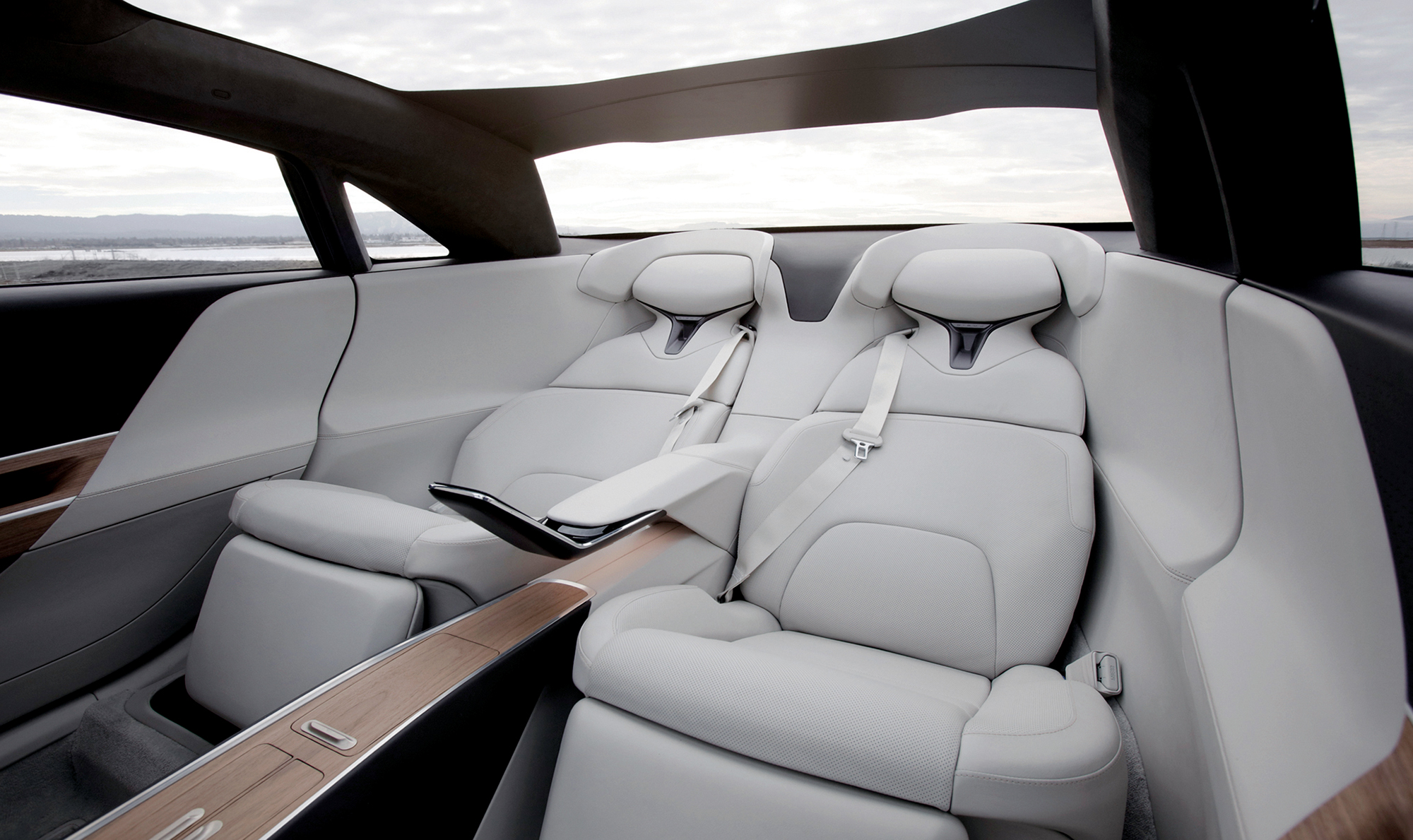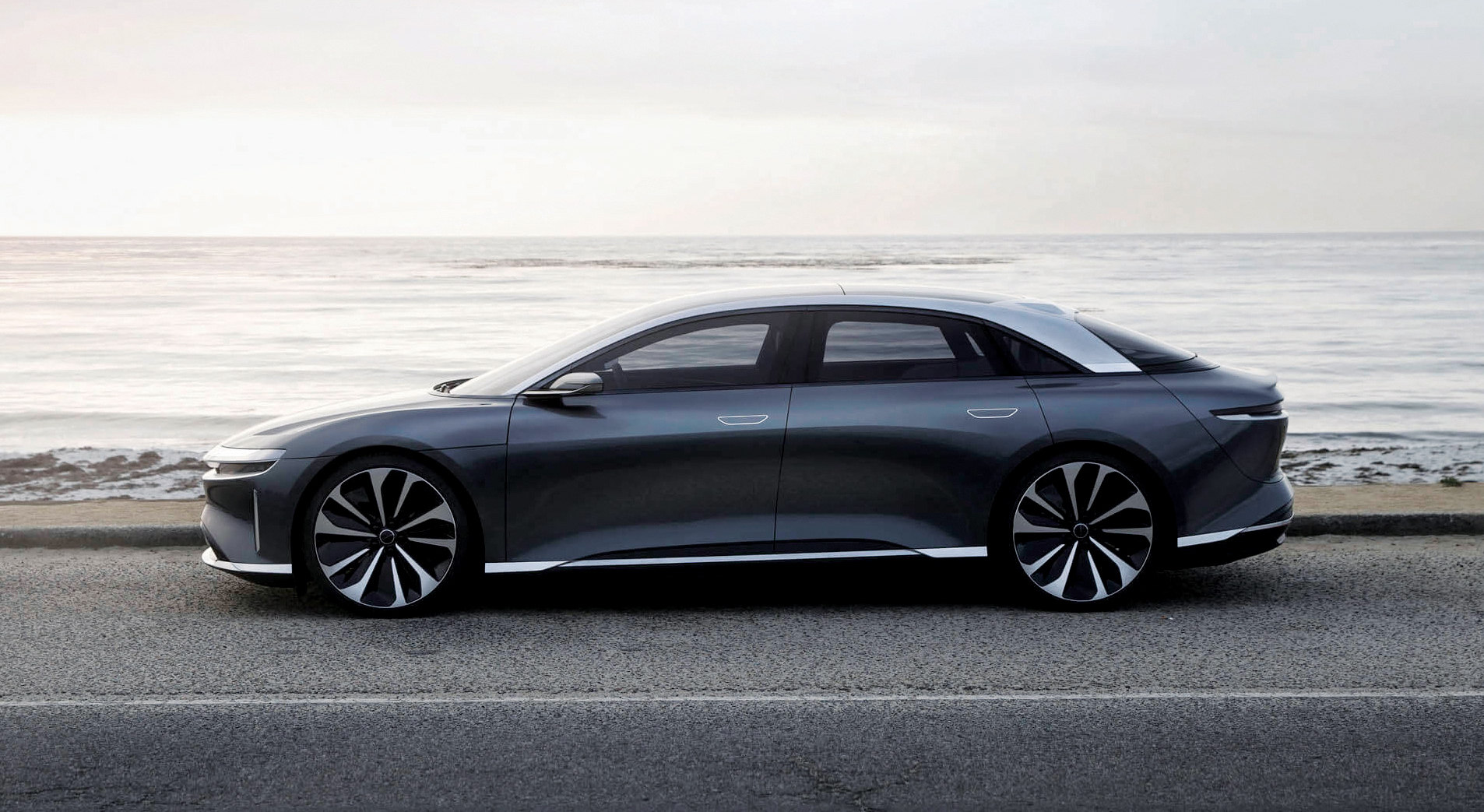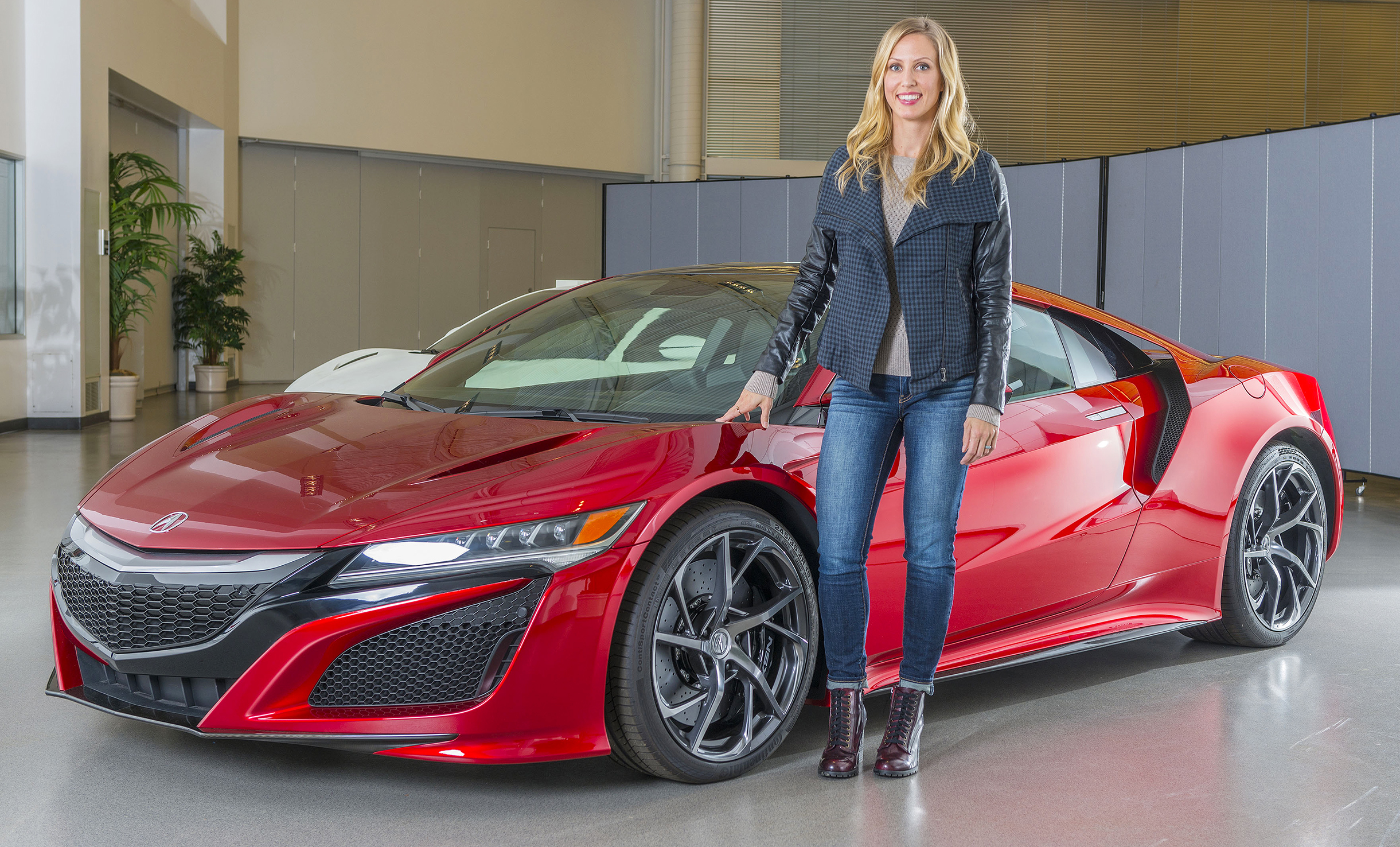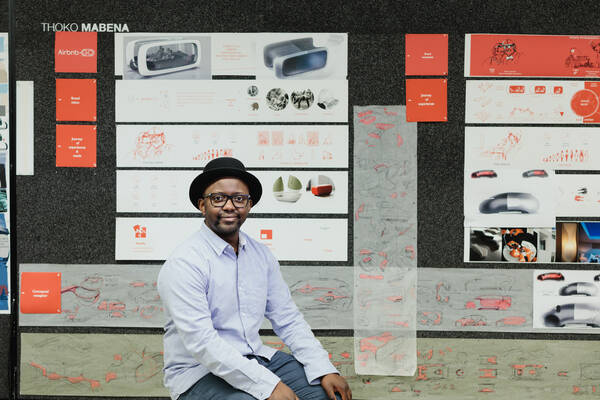
feature / transportation-design / alumni / students / faculty / internships
April 06, 2018
Writer: Solvej Schou
REVVED UP: WOMEN IN TRANSPORTATION DESIGN GAIN MOMENTUM
On a bright, sunny day at ArtCenter’s Hillside Campus, just before the start of the Spring 2018 term, Transportation Design alumna Joann Jung (BS 2002) walks down a winding hallway and comes face-to-face with newly graduated Transportation Design student Jasmine Geehee Park.
Park is busy hanging posters in the hallway, creating an encore presentation of her work shown at the Fall 2017 Grad Show. She looks at Jung, senior design manager of interior design at Lucid Motors, and lets out a gasp. The two had bonded when Jung visited the College a few months earlier. Jung gives Park—whose passion is also interior car design—a big hug, then gauges her work.
“I tell students, ‘Be loud! With color, with your design. Don’t be timid.’ See, she’s being loud here,” says Jung, pointing to a green shade streaked across Park’s award-winning concept sketches for a 2035 Cadillac PRX. Jung then studies a poster for a 2030 SUV that Park conceptualized during an internship at Calty Design Research Inc. at Lexus-Toyota in Newport Beach. Inspired by the novel The Secret Garden, the vehicle unfolds like a butterfly, features spaces for both private and social moments, and sports a top that opens. “Passengers can breathe the air and actually feel it,” remarks Park, who recently landed a junior interior designer position at Hyundai America in Irvine. “I think that women, like me, are able to be emotional in our approaches to design, which is a strong selling point.”

I have a superpower, and part of it is being female, and part of it is realizing how different we can be and what we can bring.
Joann Jung
While women own nearly half of all vehicles in the United States—42 percent of vehicles in 2016 were registered to women, according to auto website Edmunds—they comprise only a fraction of the industry’s transportation designers. That, according to ArtCenter students, alumnae and faculty, is changing.
“There’s a movement of women supporting women inside and outside of the car industry,” says Jung, now growing philosophical at Hillside’s cafeteria patio, with a breathtaking view of the San Gabriel Mountains as a backdrop. “Boys traditionally grow up with cars, and there’s a misconception that car design means mechanical engineering, but having broad knowledge is a positive tool. I have a superpower, and part of it is being female, and part of it is realizing how different we can be and what we can bring: influences like architecture, fashion and art.”
Jung and Park, a generation apart, were both born in South Korea and grew up painting and sculpting. Both found their path to ArtCenter by falling in love with a car. For Park, it was a yellow Lamborghini she saw as a teenager that inspired her to Google “how to be a car designer.” ArtCenter was the top search result. For Jung, who immigrated to the United States when she was 16, it was a blue Dodge Viper she saw on an ArtCenter for Teens (then Saturday High) field trip to the L.A. Auto Show. “I literally crouched down eye-to eye with the headlights. It was a larger-than-life sculpture, pure beauty,” says Jung.

At the time Jung went to the College, she was only one of four female designers in the undergraduate Transportation Design Department. After designing a three-wheel roadster for her senior thesis project, Jung landed a job at Ford, where she worked for 12 years. She counts the redesign of the 2014 Ford F-150’s interior among her accomplishments. At Northern California start-up Lucid Motors for the past three years, Jung led the interior design for its electric luxury car Lucid Air, which features intuitive touch screens and material that transitions from dark to light. “A car interior is never just an interior, it’s interaction,” she says. “It’s a space that moves fast and is intimate. And it’s becoming more so.”
The growing number of female vehicle consumers and drivers also reflects a widened arc, from college students to moms with multiple kids, says Jessica Caldwell, Edmunds’ executive director of industry analysis. “That’s a catalyst for women designing for the needs of women. And beyond male and female, a diverse perspective is ideal,” she says.
Named Motor Trend’s 2018 Person of the Year, General Motors CEO and Chairman Mary Barra is widely acknowledged for bumping up GM’s profits, and also for supporting equity. “The women of GM Design are making huge contributions to the auto industry. Their ideas and solutions are driving expressive designs that customers love,” she says in an emailed statement to Dot. “Our industry is changing very quickly, and I encourage more young artists to consider careers in automotive design.”


When you look at a design outcome, you shouldn’t know whether a man or woman worked on it. I hire a designer because of what they bring to the table.
Tisha Johnson
For Transportation Design alumna Tisha Johnson (BS 99), vice president of interior design at Sweden’s Volvo, taking a vehicle from a blip of an idea to production is an incredible process. From Orange County, Johnson drew cars early on, including surf mobiles for her surf-loving dad. “I’m attracted to moving quickly,” she says by phone, driving home from work in Gothenburg, Sweden. “I surf, I love motorcycles, I used to sky-dive. Cars are a natural extension of that fascination with motion.”
Johnson applied to ArtCenter in her early 20s after a friend saw she was converting her drawings into sculpted models. She then checked out Hillside’s student gallery of Transportation Design work. While part of a Volvo-sponsored project at the College, she did a full-scale interior proposal, and got a job at Volvo after graduating. “With interiors, you have multiple products within one environment, and that’s great to design,” she says.
Johnson helped bring to fruition the Volvo S90 luxury sedan—which debuted in the U.S. in 2016—as the model’s lead design manager. The car includes an instrument panel made from an elegant section of linear walnut. For the XC90 Excellence, a four-seat SUV that also debuted stateside in 2016, Johnson and her team created a retractable touch screen and a rotating child seat to make transporting kids easier.
As for the difference between male and female designers, “When you look at a design outcome, you shouldn’t know whether a man or woman worked on it,” she says. “I hire a designer because of what they bring to the table.”

While ArtCenter’s undergraduate Transportation Design program, headed by Chair Stewart Reed (BS 69 Transportation), centers around both styling and modern solutions to social, political and technical challenges facing the automotive industry, with two new concentrations—Alternative Transportation and Vehicle Interiors—the graduate Transportation Systems and Design program focuses on creating solutions at a systems level. Headed by Executive Director Geoff Wardle, it encompasses design methodology,
customer-driven research and systems thinking.
“In my experience, women designing systems tend to be very collaborative and focus on safety, the needs of kids going to school, on aging parents, and thinking broadly of all the trips people make, not just to and from work,” says Seleta Reynolds, general manager of the L.A. Department of Transportation, who notes that there has been a rise in women leading municipal transportation departments across the U.S. over the past few years.
For Transportation Systems and Design student Shinngaram Choi, participating in a Honda Research and Development-sponsored project focused on designing an autonomous vehicle for women in 2030 segued into a Fall 2017 internship at Honda R&D Americas in Ohio. The team-based project, a collaboration between Honda, ArtCenter and Ohio State University, was led by Wardle, Interaction Design Department Chair Maggie Hendrie and Humanities and Sciences Associate Professor Candice-Leigh Baumgardner. Students conducted interviews with women and used 3D digital models, VR, animation and mock-ups. Joan Smith, senior engineer at Honda R&D, created the brief, and Honda bought the project afterward. Its details are guarded.

“This is a rare, exciting project, and it’s also not stereotypical,” says Choi by phone from Ohio. Hendrie, Baumgardner and their students—female and male—reframed the original brief after research and careful conversations about gender. “Instead of asking, ‘How do we design a car for women, and what does it look like?’ we ultimately decided to ask, ‘What can we learn from women about how to design a great car?’” says Baumgardner.
Having skilled female students in the classroom also gives male students a voice for how to advocate for having more women at their work, says Hendrie. “We are modeling to them what classrooms and project relationships look like when there’s no glass ceiling to be broken, and that’s also reflected by a teaching team that’s diverse,” says the Scotland native. In 2017, in an effort to further focus on representation, ArtCenter launched a Women in Art and Design initiative, with events including the College’s first-ever Women in Industrial Design forum and a 2018 Women, Diversity and Technology panel.
Choi, who grew up in South Korea, was drawn to ArtCenter after getting her bachelor’s degree in product design in Detroit. “I wasn’t interested in transportation systems until I started looking at the big picture of what new technologies and autonomous vehicles can do for the user,” she says. Her courses at ArtCenter have ranged from the Hendrie-taught Interaction Design Studio, in which she conducted a usability study on how to enhance people’s experiences with L.A. Metro’s ticket-vending machines, to the Baumgardner-taught Concept and Systems Design Studio, in which she researched commuting as a cyclist. For a Transportation Studio 5B course taught by Jose Wyszogrod (BS 96 Transportation), chief designer at Honda R&D Americas, Choi conceptualized a Mercedes-Benz car that can switch between manual and autonomous modes. She now finds herself in between wanting to pursue interior design, user experience design and user interface design. “I hope I can be the bridge between them all,” says Choi.


One of my personal goals is to keep pushing the emotional aspect of cars and the joy of driving.
Michelle Christensen
For alumna Michelle Christensen (BS 05 Transportation Design), former lead principal designer at Acura Exterior at Honda R&D, the appeal of exterior car design is its visual impact and expressiveness. This past January, in the glass-walled lobby of Acura’s design studio at the U.S. headquarters of Honda in Torrance, about 20 miles southeast of Los Angeles, Christensen stands next to a gleaming white model of Acura’s NSX, its next-generation supercar that debuted in 2015. As the NSX’s lead designer, she exudes pride when talking about the car, which features a twin-turbocharged V-6 engine, three electric motors and a streamlined body. “There are visual cues—huge air intakes for the turbocharged engine—that we exaggerated to convey that this is powerful, muscular and fast,” she says.
Raised in San Jose, Christensen grew up following her dad around the garage and driving with him in his ’32 Ford to hot rod shows, her hair whipping in the wind. She now drives both an Acura RDX SUV and a ’65 Chevrolet Chevelle.
“The love for speed, analog things and how things work mechanically has always burned in my blood,” says the designer, as a World War II airplane from a local airport whirs overhead. “One of my personal goals is to keep pushing the emotional aspect of cars and the joy of driving.”

Originally torn between fashion design and car design, Christensen didn’t even know studying the latter was an option until she found out about ArtCenter. When she first took her high school portfolio to the College, it didn’t contain any car sketches, so a counselor suggested she take an ArtCenter at Night class to bump up her skills. After getting accepted into Transportation Design, she dove into projects like sculpting a concept car in silver and green-blue tones for Danish consumer electronics brand Bang & Olufsen. She got a job at Honda after graduating.
“When I went to ArtCenter, all I wanted was to one day see a car on the road that I helped design,” says Christensen. “The College showed me what working hard means, and it raised my own internal standards for everything I do.” As a woman in an often-described “boys’ club,” she tries to shake off stereotypes and not be pigeonholed.
“One thing that’s really helped me is finding mentors,” she says. “Find those people rooting for you, regardless of your age, gender or anything else, and who you respect, can bounce ideas off of or ask for advice. When there’s all the other noise, keep your sights set on your goals.”




